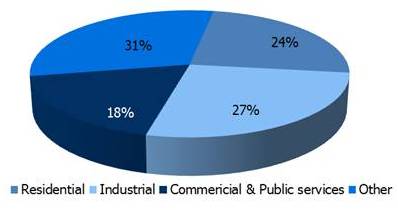_36.jpg)
Kuwait Financial Centre “Markaz” recently published the executive summary of their infrastructure series covering: Power, Airports, Seaports, Roads & Railways, ICT and Water. In this research note, Markaz tackles Qatar Power sector in terms of highlighting demand-supply trends, growth drivers, and future investment areas.
Qatar is one of the few countries in the Gulf, where power generation has grown considerably in the last decade. Because of high GDP growth rates and population explosion, power consumption in Qatar has increased by a CAGR of 9.3% between 2001 and 2011. To keep pace with the demand, Qatar saw its installed power capacity getting doubled in just two years, from 2009 to 2011. We expect Qatar’s per capita power consumption to remain as one of the highest in the GCC.
Qatar Electricity Consumption by User
Qatar General Electricity & Water Corporation (Kahramaa) is the ultimate body which caters to electricity and water needs of Qatar. Kahramaa entered into an agreement, in December 2002, with Qatar Electricity & Water Company (QEWC) to transfer all its power stations to QEWC. Thus, Kahramaa now concentrates on transmission and distribution, while QEWC takes care of generation. Independent Water & Power Projects (IWPPs) in Qatar are formed as public stock companies with QEWC as a major shareholder.
Due to rapid expansion in generation capacity, Qatar currently enjoys very high reserve margin of almost 40%. Hence Qatar General Electricity & Water Corporation (Kahramaa) has announced no further capacity building plans till 2014 but focus will be in the transmission and distribution sector. Over a dozen of projects are under execution in transmission and distribution sector, with a gross investment of USD 4bn.
Qatar, being one of the largest per capita greenhouse emitter in the world, is committed to reducing the levels. Qatar National Vision 2030 has stated its ambition to use non-hydrocarbon mechanisms for power generation. Recently, Qatar announced plans to utilize solar power for cooling the 2022 FIFA World Cup stadia. The solar power complex project, announced by Kahramaa, which was estimated to have a capacity of 3,500MW capacity, is put on hold. Kahramaa might resume work on this project, after 2015, as part of capacity building plan.
Because of high reserve margins, Qatar could look forward to electricity exports through the Gulf Cooperation Council Interconnection Authority (GCCIA) power grid. Bahrain and Kuwait have reportedly shown interest in purchasing electricity from Qatar.
Natural gas is the only source fuelling power plants in Qatar and the country does not have any major alternate energy projects which are under execution. Going forward, creating opportunities and making investments in the alternate energy space will be important for Qatar.
###
Kuwait Financial Centre K.P.S.C “Markaz”, with total assets under management of over KD903 million (USD 3.2 billion) as of December 31, 2012, was established in 1974 has become one of the leading asset management and investment banking institutions in the Arabian Gulf Region. Markaz was listed on the Kuwait Stock Exchange (KSE) in 1997.

